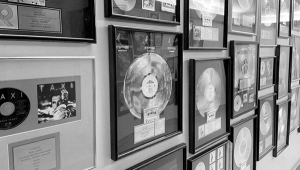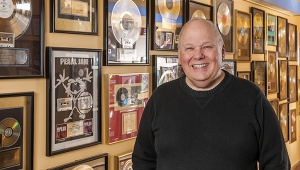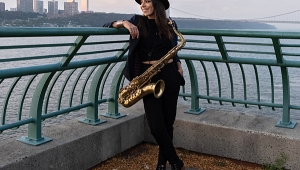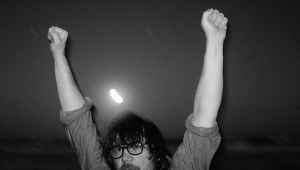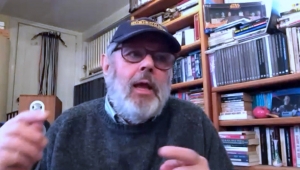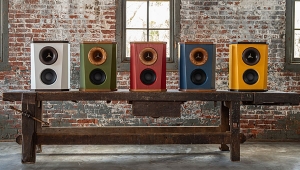| Columns Retired Columns & Blogs |
Poem: Stereophile Cuts an LP Page 3
Another take revealed that the sound off tape was now, well, delicious. It had captured both the sounds of the instruments accurately but also the sense that those instruments were in that particular hall, with their spatial relationships intact. I smiled. We were in for an easy two days' recording. Kavi was not looking so happy, however. "I'll play it again. Listen for a ticking in the left channel." He did. I did. I heard a faint ticking with a period of about 0.25s, quite audible despite being some 60dB down from the peak level. One of the mics had gone bad. With that long a period, it could have been anything—the capsule or, with the high impedances floating around inside the mic, a capacitor, even a tube. (The mic uses a single 6DJ8 dual triode with its two halves cascoded; this voltage amp then drives an output transformer the size of my fist.) Hoping that it was the tube, we dispatched Kavi's assistant Chris Donnelly to the nearest Audio Research dealer, Optimal Enchantment, to buy a replacement pair of low-noise 6DJ8s. But what to do in the meantime?
Record the Reinecke with a different pair of microphones, of course, so that on the resultant record, we could demonstrate how using different mics with a different technique would change both the sound and the soundstage. Resourceful, us New Mexicans! Kavi, of course, carries backups of everything (except 6DJ8s!), so he proceeded to set up a pair of Milab LC25 cardioid transformerless microphones in a quasi-ORTF arrangement, the capsules separated by a few inches and angled by 90 degrees or so. Gary and Brooks kindly played the Reinecke first movement a few more times while Kavi got a handle on the sound of the new mics—this time it was the included angle between the mics that most affected the balance between soundstage solidity and the correct ratio between direct and reflected sounds. With the angle opened out to the recommended 115 degrees, the soundstage developed a hole in the middle, hence the smaller angle chosen. Overall, the sound was good, but a slight degree of treble prominence overlaid the instruments' tonalities compared with Tim's tube mics. In addition, the LC25's cardioid pattern added an immediacy to the sonic picture that, while quite appealing, was definitely a departure from ultimate accuracy. It also slightly accentuated extraneous noises made by the musicians—flute key clatter, piano pedal noise, music rustles, creaks from the stage—and the left-hand registers of the piano lost some of the growl that they had in reality.
What could we do? We only had the hall for two days and could not afford to waste any of that precious time. Time for a take.
"I believe we're up to Take 7," announced Gary. Richard and I, brows suitably furrowed, followed the score, prepared to mark any wrong note or extraneous noise, while I kept the overall log, noting where each take started and stopped, where each take had problems (if any), which ones the musicians liked, what takes were on what reel of tape, and marking suitable edit points in the score if one were needed. Take 7 turned out to be good enough to use, although an incomplete ending necessitated further retakes. Take 11 was excellent, apart from some extraneous noises in the first half, so a composite of the two appeared to be a suitable recipe for the version that would appear on the record. The musicians were happy with this, so on we went, to the work's second movement.
 "There's a hum." said Kavi. He was right, there was a hum, quite audible in the headphones. I groaned. It was now 4pm and we were still embroiled in the second movement of the Reinecke. But where was the hum coming from? I went out in the hall—it was an acoustic hum! "It's the airconditioning compressor," said Gary. "We'll have to wait for it to go off." We also found that the college clock very audibly struck the hours and half hours. Thus we proceeded until 7pm, squeezing in takes between the clock chimes and the periods when the compressor decided to sing. (Sited on the roof of the next building, it was amazingly audible in the hall and couldn't be turned off.) The three remaining movements of the Reinecke were caught on tape with only minor difficulty—"There's a big noise outside?" asked Gary at one point, which turned out to be film technicians hosing down the hall exterior for a rainy-day sequence in a film being shot on the USC campus—and the day ended with a number of takes of the Griffes Poem. This was more for backup, however, as I was hoping that the tube mics, resplendent with $100 worth of new 6DJ8s, would be functional the next day.
"There's a hum." said Kavi. He was right, there was a hum, quite audible in the headphones. I groaned. It was now 4pm and we were still embroiled in the second movement of the Reinecke. But where was the hum coming from? I went out in the hall—it was an acoustic hum! "It's the airconditioning compressor," said Gary. "We'll have to wait for it to go off." We also found that the college clock very audibly struck the hours and half hours. Thus we proceeded until 7pm, squeezing in takes between the clock chimes and the periods when the compressor decided to sing. (Sited on the roof of the next building, it was amazingly audible in the hall and couldn't be turned off.) The three remaining movements of the Reinecke were caught on tape with only minor difficulty—"There's a big noise outside?" asked Gary at one point, which turned out to be film technicians hosing down the hall exterior for a rainy-day sequence in a film being shot on the USC campus—and the day ended with a number of takes of the Griffes Poem. This was more for backup, however, as I was hoping that the tube mics, resplendent with $100 worth of new 6DJ8s, would be functional the next day.
Fresh from Chicago, Larry Archibald joined us at breakfast the next morning, as did a despondent Kavi. "We fitted the new tubes, but the mic now doesn't work at all." It turned out that, suspecting a capacitor in the noisy mic, Chris Donnelly had also replaced that before he had to head back to Santa Barbara. All we could do was to dismantle the mic to see what had happened. First, however, we set down to finish the Griffes with the Milab cardioids. Best we get that under our belts before attempting any major resetting up. And the hum had gone for good. The Griffes safely captured, I sat down among a pile of microphone pieces, comparing the circuit board of the "repaired" microphone with that of the functional one, while Richard Lehnert sat down with Gary to get some background both on his career and on his feelings about the Stereophile sessions.
"Aha!" In replacing the capacitor on the tiny, densely populated pcb, Chris had inadvertently bridged two traces with a minuscule whisker of solder. No problem fixing that. I reassembled the mics and Kavi set them back up in their shock mounts. We listened over the headphones. The ticking was still there, but with a difference. The period was shorter and was noticeably speeding up. All I could think of was that it was due to moisture in the capsule and that as the water evaporated, the tick would get faster and faster until it vanished.
- Log in or register to post comments

